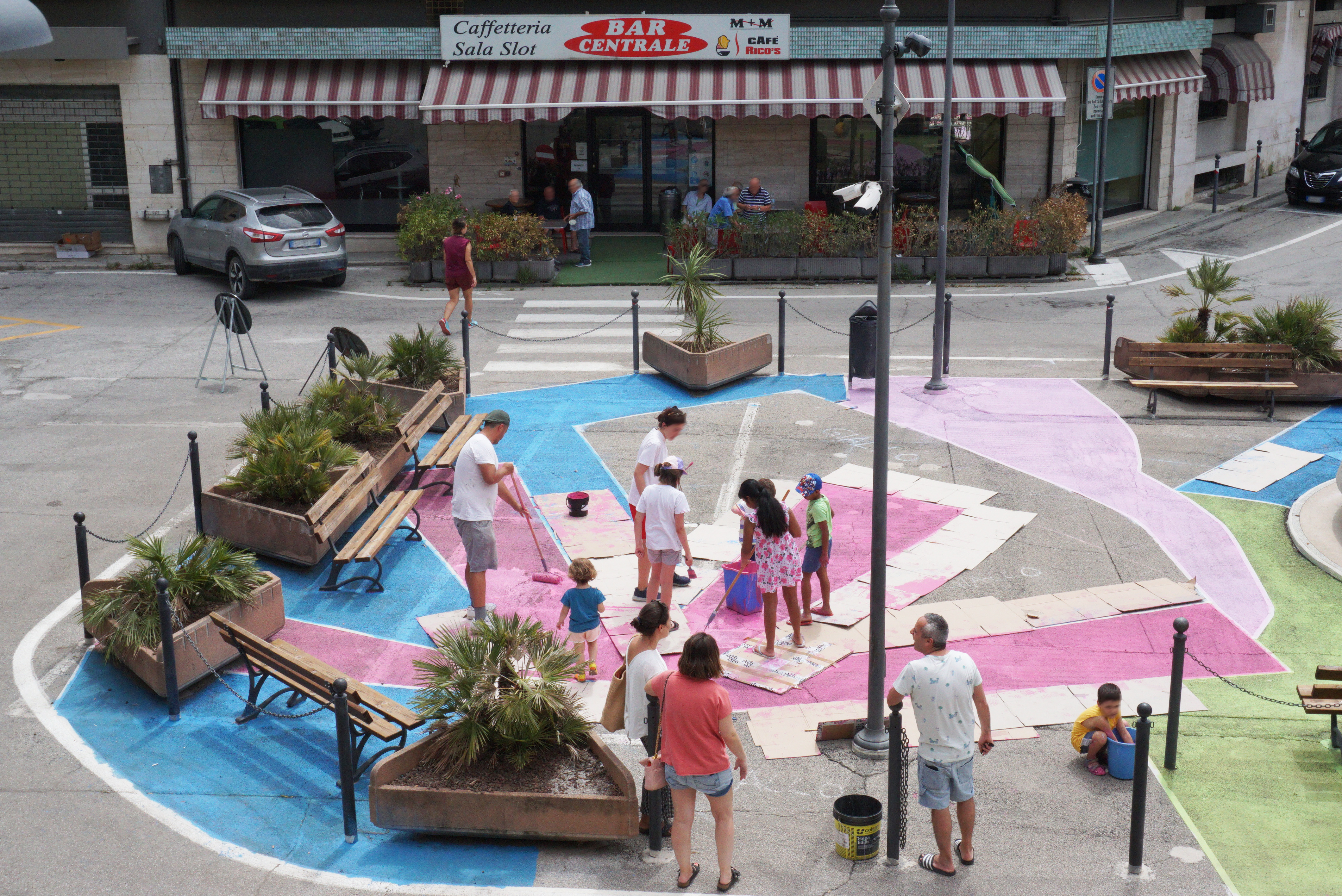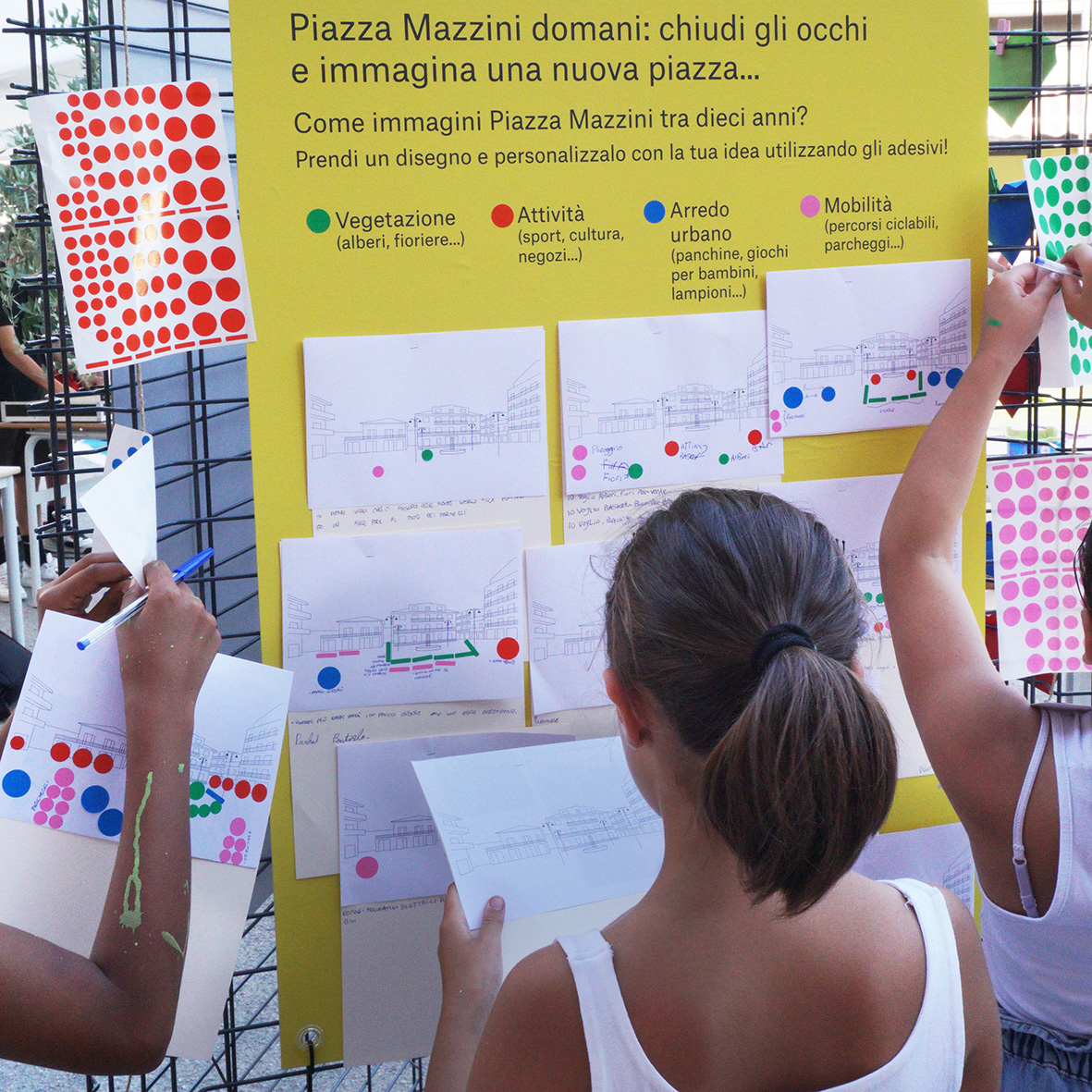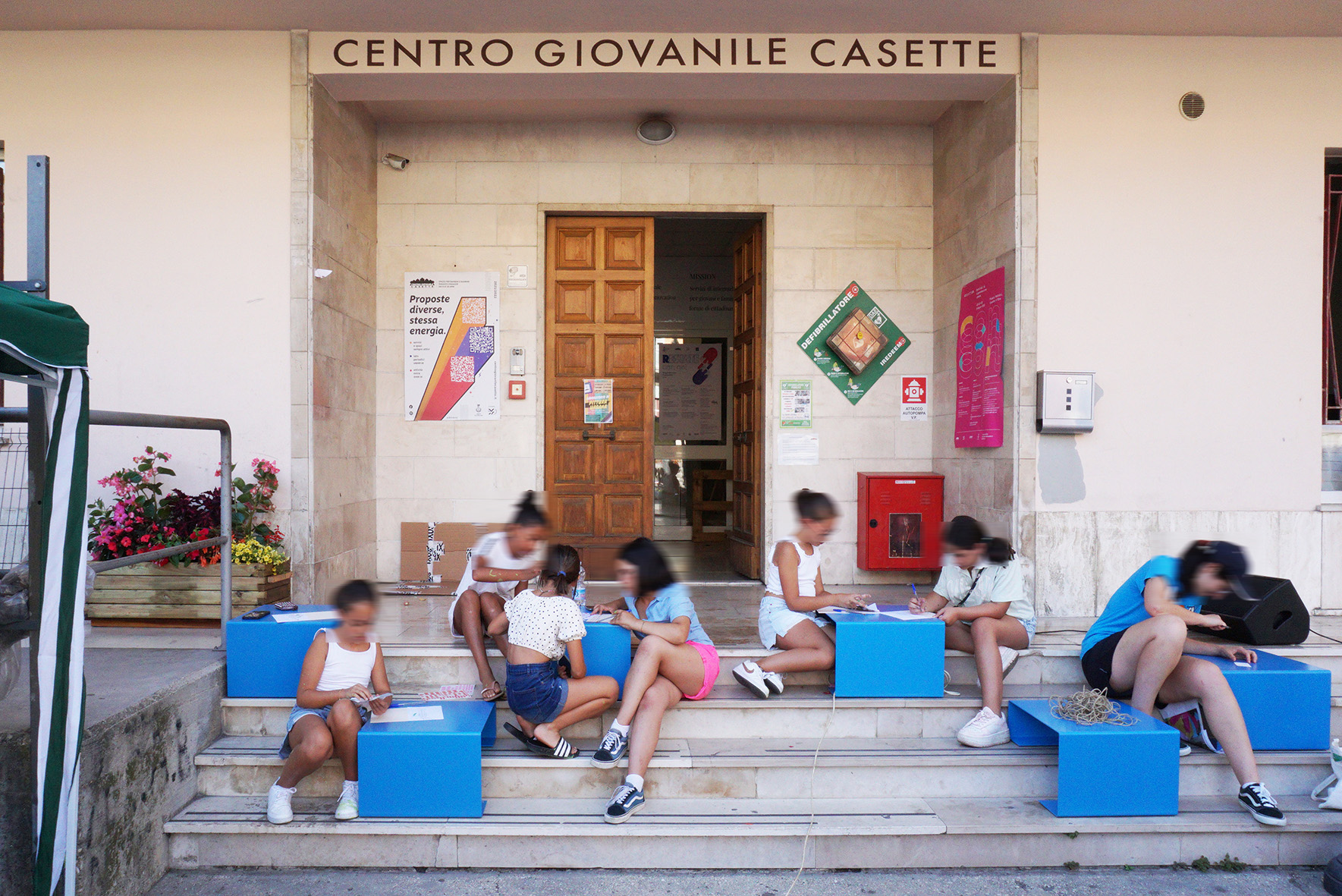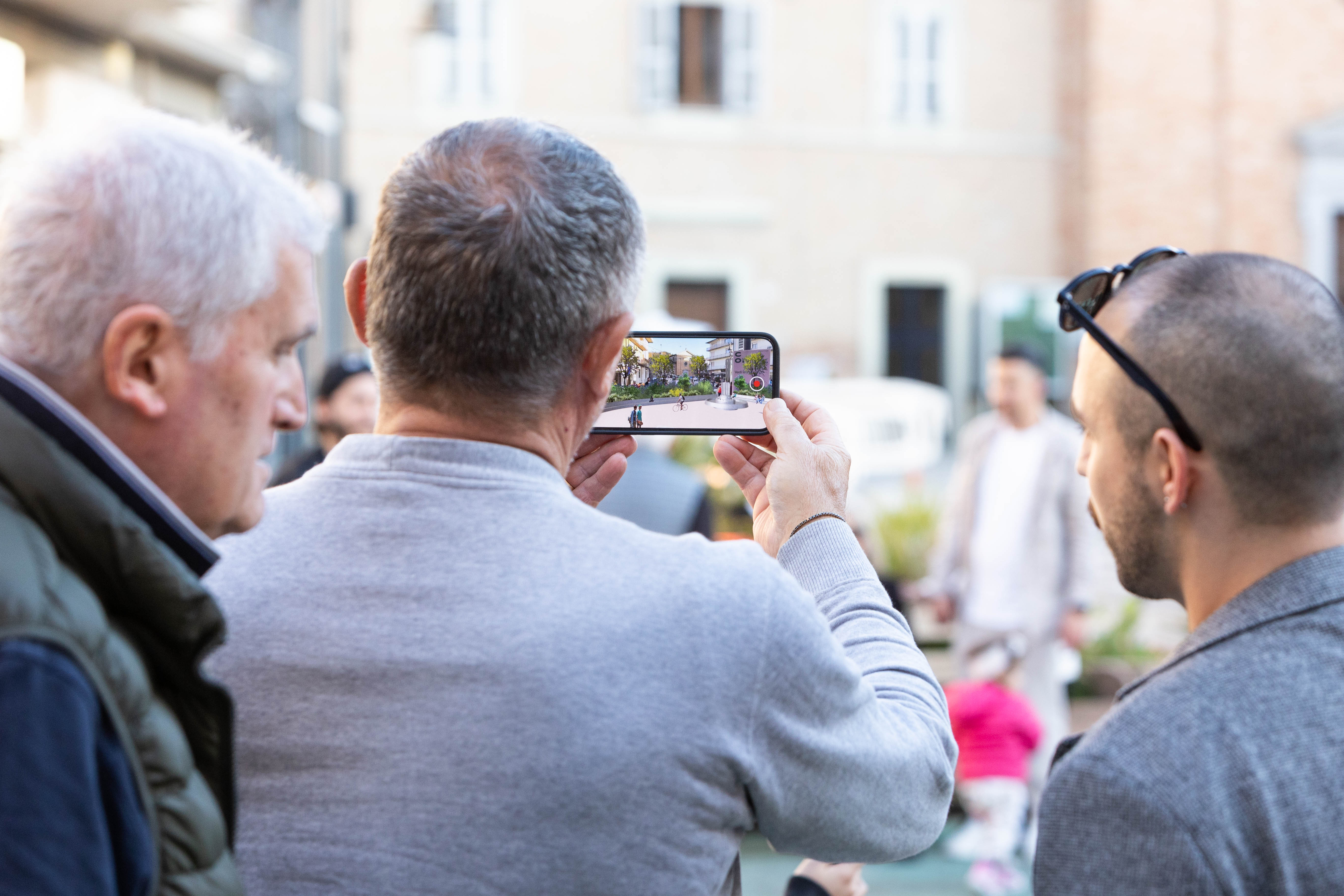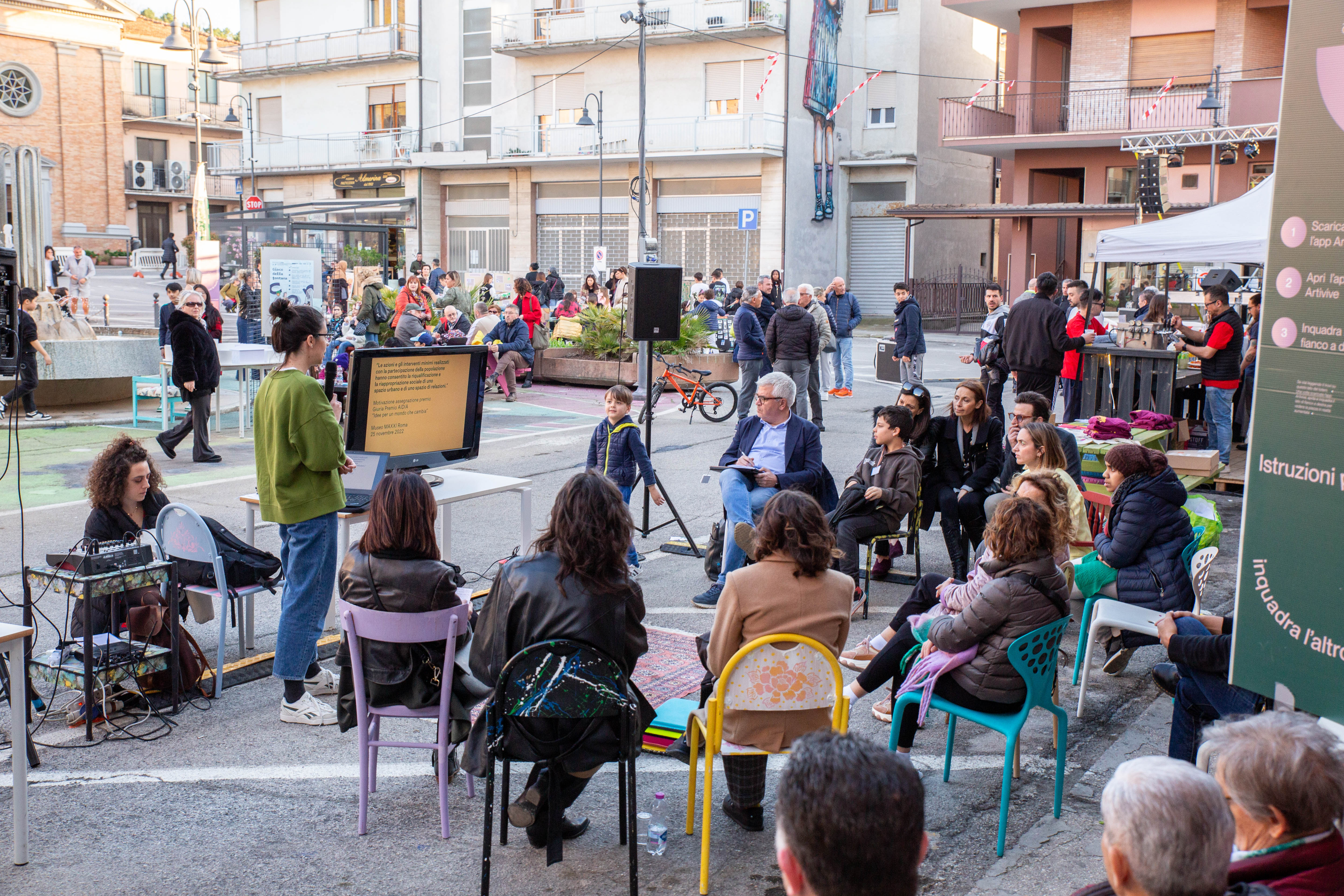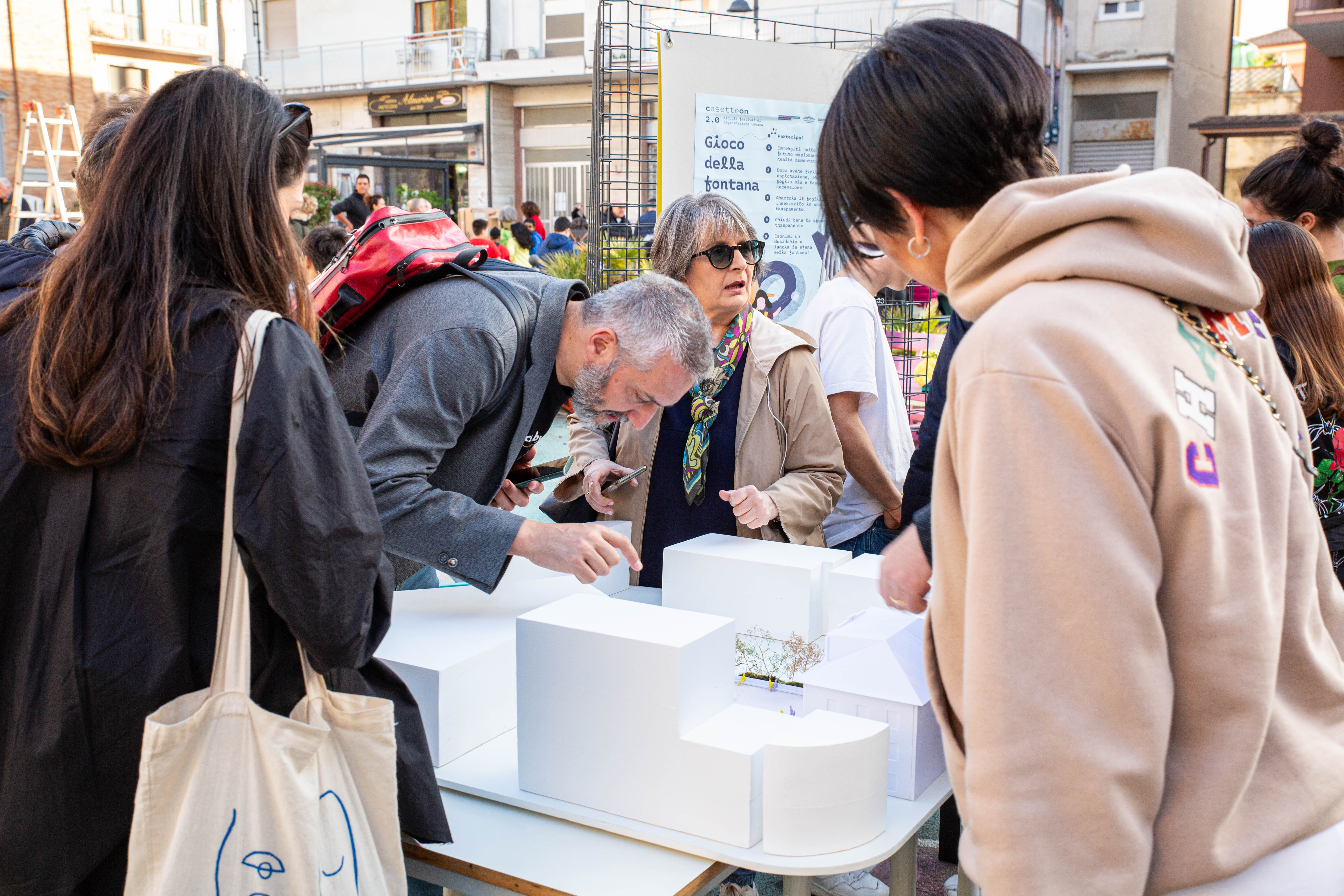Casette ON
Casette ON: a teenage-led initiative for the urban revolution of small municipalities in Europe.
Can the 15-minute-city potential of European small municipalities be unlocked by teenagers and start a local yet global revolution?
The project “Casette ON” is a beautiful story of youth empowerment for the circular design of public space.
Thanks to an inclusive participatory process, the local community of Sant’Elpidio a Mare (Italy) reshapes the square “Piazza Mazzini”, turning it from a space for cars to a space for people, while dreaming of carbon-neutrality and climate resilience.
The project “Casette ON” is a beautiful story of youth empowerment for the circular design of public space.
Thanks to an inclusive participatory process, the local community of Sant’Elpidio a Mare (Italy) reshapes the square “Piazza Mazzini”, turning it from a space for cars to a space for people, while dreaming of carbon-neutrality and climate resilience.
Italy
Piazza Mazzini, Casette D’Ete, 63811 Sant’Elpidio a Mare, Italy.
Prototype level
Yes
Yes
Yes
No
No
109037: Sant'Elpidio a Mare (IT)
The project “Casette ON” consists of an initiative started by teenagers for the urban regeneration of the square “Piazza Mazzini” in the small municipality of Sant’Elpidio a Mare (Italy).
As a matter of fact, the square, located in a 15-minute walkable neighbourhood “Casette d’Ete, is used mainly as a parking area, making the public space unsafe and unattractive for social encounters.
The overall aim of the project is to transform the square into the beating heart of the neighbourhood: an active space for stimulating encounters and climate comfort, shaped by teenage energy.
In 2022 the Youth Center “Centro Giovanile Casette” (CGC), which is located on “Piazza Mazzini” and which provides recreational activities for teenagers, started a participatory process, based on an adaptive, inclusive and interactive approach.
Coordinated by young architects, they organised an urban festival to listen to opinions and desires from the teenagers and from the local community (target groups), in order to prepare a bottom-up collective proposal for the new square.
Temporary events turned the square into a test-site for urban experiments and started a big revolution for a small municipality: “Casette d’Ete” turned on, thanks to community engagement, intergenerational and cultural exchange and a creative contamination of disciplines.
What are the specific objectives?
- Youth empowerment.
- Climate justice.
- Promote healthy and carbon-free lifestyles.
- Enhance a sense of belonging.
- Reclaim the street and open it to pedestrians.
- Make social diversity thrive.
What are the expected outcomes?
- Implementation of the new square “Piazza Mazzini”, from technical design to realisation.
- Urban regeneration of the neighbourhood based on the 15-minute-city potential (pilot project).
- Inversion of the depopulation trend happening in small municipalities, thanks to the transformation of the public space from car-centered to human- and nature-centered.
As a matter of fact, the square, located in a 15-minute walkable neighbourhood “Casette d’Ete, is used mainly as a parking area, making the public space unsafe and unattractive for social encounters.
The overall aim of the project is to transform the square into the beating heart of the neighbourhood: an active space for stimulating encounters and climate comfort, shaped by teenage energy.
In 2022 the Youth Center “Centro Giovanile Casette” (CGC), which is located on “Piazza Mazzini” and which provides recreational activities for teenagers, started a participatory process, based on an adaptive, inclusive and interactive approach.
Coordinated by young architects, they organised an urban festival to listen to opinions and desires from the teenagers and from the local community (target groups), in order to prepare a bottom-up collective proposal for the new square.
Temporary events turned the square into a test-site for urban experiments and started a big revolution for a small municipality: “Casette d’Ete” turned on, thanks to community engagement, intergenerational and cultural exchange and a creative contamination of disciplines.
What are the specific objectives?
- Youth empowerment.
- Climate justice.
- Promote healthy and carbon-free lifestyles.
- Enhance a sense of belonging.
- Reclaim the street and open it to pedestrians.
- Make social diversity thrive.
What are the expected outcomes?
- Implementation of the new square “Piazza Mazzini”, from technical design to realisation.
- Urban regeneration of the neighbourhood based on the 15-minute-city potential (pilot project).
- Inversion of the depopulation trend happening in small municipalities, thanks to the transformation of the public space from car-centered to human- and nature-centered.
Youth empowerment
Community engagement
Climate justice
15-minute-city potential
Urban innovation
The project “Casette ON” aims at promoting activities that encourage preservation, regeneration and lifecycle thinking.
In fact, it reimagines the built environment as a circular system by empowering the hidden potential of the local context, reusing existing elements and advancing ecodesign.
The starting point of the project is the dream of the local community to co-create a new square, which is, first of all, liberated by cars and then able to reconnect with the natural landscape around it and to provide environmental comfort.
Just to mention some, the project area “Piazza Mazzini”:
- is fully covered by asphalt and does not provide water-permeability, which represents high flood-risk during heavy rains due to the flat landscape;
- does not provide shadow during heat waves, which makes staying in the public space not possible.
Therefore key objectives in terms of environmental sustainability are:
1. Transforming the square into a climate shelter by improving the climate resilience of the public space: vegetation is used as a multi-purpose tool (1).
2. Reducing the environmental impact of human activities through the promotion of carbon-free lifestyles, such as enhancing bike and walk mobility.
3. Preventing biodiversity loss thanks to the introduction of vegetation and the use of nature-based materials.
Moreover co-created green elements would improve the biophilic aspect of the public space, reconnecting humans with nature and improving urban health.
In conclusion, this project is exemplary because it introduces innovative topics, such as co-designed urban regeneration and climate shelters as common goods, in small municipalities: in other words it enables big revolutions in small places.
Sustainability means preserving the ecosystemic beauty of a place for future generations.
In fact, it reimagines the built environment as a circular system by empowering the hidden potential of the local context, reusing existing elements and advancing ecodesign.
The starting point of the project is the dream of the local community to co-create a new square, which is, first of all, liberated by cars and then able to reconnect with the natural landscape around it and to provide environmental comfort.
Just to mention some, the project area “Piazza Mazzini”:
- is fully covered by asphalt and does not provide water-permeability, which represents high flood-risk during heavy rains due to the flat landscape;
- does not provide shadow during heat waves, which makes staying in the public space not possible.
Therefore key objectives in terms of environmental sustainability are:
1. Transforming the square into a climate shelter by improving the climate resilience of the public space: vegetation is used as a multi-purpose tool (1).
2. Reducing the environmental impact of human activities through the promotion of carbon-free lifestyles, such as enhancing bike and walk mobility.
3. Preventing biodiversity loss thanks to the introduction of vegetation and the use of nature-based materials.
Moreover co-created green elements would improve the biophilic aspect of the public space, reconnecting humans with nature and improving urban health.
In conclusion, this project is exemplary because it introduces innovative topics, such as co-designed urban regeneration and climate shelters as common goods, in small municipalities: in other words it enables big revolutions in small places.
Sustainability means preserving the ecosystemic beauty of a place for future generations.
The project “Casette ON” aims at fostering a sense of belonging through meaningful experiences, such as the authentic act of listening: listening to future desires, present perceptions and past memories of the community.
Guided by urban design experts, the participatory project enables an opportunity, for the local community, to pause, listen to each other and reflect collectively on common goods with the lens of EMOTIONS.
Therefore key objectives in terms of aesthetics and quality of experience for people are:
1. Strengthening social cohesion by creating community engagement in the transformation of the square (excitement).
Not taking the offline social network for granted, rather acknowledging the beauty of physical social interactions and strengthening them (serotonin released by social interaction).
2. Empowering young citizens (self-confidence)
Often excluded from city-making decisions, teenagers turn into active key-players for a chance in the context they live in.
The public space becomes a space where they feel welcomed to express their needs, fragilities, freedom, energy, a space where they can imagine their future.
3. Building community trust
Re-establishing an interactive relationship between the local administration and the civic society.
Why exemplary:
In conclusion, this project is exemplary because it includes the young generation in the urban story-telling of the present and reconnects them to the community, instead of setting them apart.
This project realizes an intergenerational exchange and gives young generations the lead, considering them citizens of the present rather than of the future.
How can we stop the abandonment of small municipalities? How can we invert the urban trend of depopulation in Europe?
Guided by urban design experts, the participatory project enables an opportunity, for the local community, to pause, listen to each other and reflect collectively on common goods with the lens of EMOTIONS.
Therefore key objectives in terms of aesthetics and quality of experience for people are:
1. Strengthening social cohesion by creating community engagement in the transformation of the square (excitement).
Not taking the offline social network for granted, rather acknowledging the beauty of physical social interactions and strengthening them (serotonin released by social interaction).
2. Empowering young citizens (self-confidence)
Often excluded from city-making decisions, teenagers turn into active key-players for a chance in the context they live in.
The public space becomes a space where they feel welcomed to express their needs, fragilities, freedom, energy, a space where they can imagine their future.
3. Building community trust
Re-establishing an interactive relationship between the local administration and the civic society.
Why exemplary:
In conclusion, this project is exemplary because it includes the young generation in the urban story-telling of the present and reconnects them to the community, instead of setting them apart.
This project realizes an intergenerational exchange and gives young generations the lead, considering them citizens of the present rather than of the future.
How can we stop the abandonment of small municipalities? How can we invert the urban trend of depopulation in Europe?
The project “Casette ON” aims at implementing accessibility for all and inclusive governing systems in the public space on multiple layers, from the participatory process to the urban design.
Careful attention is given to the multitude of personalities who are part of the community in order to make social diversity thrive. Therefore key objectives, in terms of inclusion, are:
1. Using accessible and diverse language.
Society is made of various personalities, which vary for age, cultural background, digital skills, neurodiversity, emotions or physical skills.
Therefore participatory workshops have been developed using engaging activities which are easy to understand and to interact with, for all.
They span from analog to digital and from offline to online, such as playful surveys, low-tech and creative workshops and collective interviews.
2. Boosting social interactions in the public space
In the initial situation, the project area “Piazza Mazzini” was used as a parking area for cars, making the public space unsafe for people, especially for the most vulnerable ones, such as children, teenagers and elderly people.
Thanks to this initiative,“Piazza Mazzini” becomes a safe space for encounters (car-free, sitting comfort, climate shelter) and a lively square, activated by outdoor events and creative workshops.
3. Setting minimum accessibility standards for urban design
Supporting vulnerable members of the community by setting the needs of children and teenagers as minimum design standards for the whole urban project (2).
The new design of the square transforms the public space into a place that is attractive, comfortable and safe first of all for children and teenagers and, as a consequence, for all.
In conclusion, this project is exemplary because it creates an inclusive and versatile system which fits everyone, attracts diverse users and boosts social gatherings in the public space.
Careful attention is given to the multitude of personalities who are part of the community in order to make social diversity thrive. Therefore key objectives, in terms of inclusion, are:
1. Using accessible and diverse language.
Society is made of various personalities, which vary for age, cultural background, digital skills, neurodiversity, emotions or physical skills.
Therefore participatory workshops have been developed using engaging activities which are easy to understand and to interact with, for all.
They span from analog to digital and from offline to online, such as playful surveys, low-tech and creative workshops and collective interviews.
2. Boosting social interactions in the public space
In the initial situation, the project area “Piazza Mazzini” was used as a parking area for cars, making the public space unsafe for people, especially for the most vulnerable ones, such as children, teenagers and elderly people.
Thanks to this initiative,“Piazza Mazzini” becomes a safe space for encounters (car-free, sitting comfort, climate shelter) and a lively square, activated by outdoor events and creative workshops.
3. Setting minimum accessibility standards for urban design
Supporting vulnerable members of the community by setting the needs of children and teenagers as minimum design standards for the whole urban project (2).
The new design of the square transforms the public space into a place that is attractive, comfortable and safe first of all for children and teenagers and, as a consequence, for all.
In conclusion, this project is exemplary because it creates an inclusive and versatile system which fits everyone, attracts diverse users and boosts social gatherings in the public space.
First of all, citizens benefiting from the project “Casette ON” have been the starting point of the project: the dream of a car-free square came from an authentic need manifested by the teenagers.
In second place, the community affected by the project has been involved throughout a structured participatory process made of various consultation workshops.
The participatory process, coordinated by young architects, consisted of an interactive approach divided in four phases:
- Phase 1, Listening (2022)
The first edition of the urban festival consisted of collecting opinions and ideas from the teenagers and the local community.
- Phase 2, Reframing
Inputs given by the participants have been reframed into thematic cores and guidelines.
- Phase 3, Shareback (2023)
Results have been presented during a public event and described in details in a final report (see Attachment 7.2).
- Phase 4, Action (2024 - ongoing)
Based on the inputs given by the community, a sketch design for the new square has been prepared and presented during the second edition of the urban festival. Specific attention was given to share-back moments, both offline and online, in order to show citizens their impact.
In conclusion, community involvement generated valuable impacts, such as:
1. Short-term implementation of the proposed guidelines in the the square, which turned partially car-free starting from 2024;
2. Contribution to the design of the new square, which will be green, car-free and teenage-friendly, following citizens’ inputs;
3. Strengthening the sense of belonging to the project area, which was called “OUR square” at the end of the process, instead of “THE square”;
4. Community building (+50% visitors during the second edition of the festival, including people with different cultural backgrounds).
To sum it up, the involvement of the community was essential for the developments of the project: its inputs will shape the future of the neighbourhood.
In second place, the community affected by the project has been involved throughout a structured participatory process made of various consultation workshops.
The participatory process, coordinated by young architects, consisted of an interactive approach divided in four phases:
- Phase 1, Listening (2022)
The first edition of the urban festival consisted of collecting opinions and ideas from the teenagers and the local community.
- Phase 2, Reframing
Inputs given by the participants have been reframed into thematic cores and guidelines.
- Phase 3, Shareback (2023)
Results have been presented during a public event and described in details in a final report (see Attachment 7.2).
- Phase 4, Action (2024 - ongoing)
Based on the inputs given by the community, a sketch design for the new square has been prepared and presented during the second edition of the urban festival. Specific attention was given to share-back moments, both offline and online, in order to show citizens their impact.
In conclusion, community involvement generated valuable impacts, such as:
1. Short-term implementation of the proposed guidelines in the the square, which turned partially car-free starting from 2024;
2. Contribution to the design of the new square, which will be green, car-free and teenage-friendly, following citizens’ inputs;
3. Strengthening the sense of belonging to the project area, which was called “OUR square” at the end of the process, instead of “THE square”;
4. Community building (+50% visitors during the second edition of the festival, including people with different cultural backgrounds).
To sum it up, the involvement of the community was essential for the developments of the project: its inputs will shape the future of the neighbourhood.
The project “Casette ON” is possible thanks to the fruitful collaboration of several stakeholders, which collaborate in an horizontal way and which are grouped together by the Youth Center CGC.
In fact, the Youth Center CGC, which promoted the project “Casette ON” works as a reference point for the whole neighbourhood and connects impartially local stake-holders, such as associations, the civil society, families with a different cultural background and shops.
On one hand, the project “Casette ON” strengthens an horizontal exchange among local actors and provides opportunities of urban engagement to them through:
- involving them in the activities of the urban festival, and sharing the stage with them;
- giving responsibilities in the co-management of the square;
- asking for their inputs in the participatory process.
The main goal is to make them feel heard on the basis of volunteer-base involvement.
On the other hand, the project “Casette ON” generates a vertical interaction between the Municipality of “Sant’Elpidio a Mare” and the civil society.
In this way it is possible to have a direct and effective exchange and build trust.
Further steps have been made thanks to the passion of local actors to promote the project, which has been acknowledged
- at national level with the Italian Award “AIDIA-Ideas for a changing world” (Rome, 2022) and
- at European level with the publication “Towards Regenerative Neighbourhoods:
European Cases, Insights, and Initiatives” made by the Circular Urban Economies Transition Pathway in the Driving Urban Transitions Partnership (2024).
In conclusion, the project “Casette ON” has been able to generate a valuable social impact thanks to a strong and effective multi-level engagement.
In fact, the Youth Center CGC, which promoted the project “Casette ON” works as a reference point for the whole neighbourhood and connects impartially local stake-holders, such as associations, the civil society, families with a different cultural background and shops.
On one hand, the project “Casette ON” strengthens an horizontal exchange among local actors and provides opportunities of urban engagement to them through:
- involving them in the activities of the urban festival, and sharing the stage with them;
- giving responsibilities in the co-management of the square;
- asking for their inputs in the participatory process.
The main goal is to make them feel heard on the basis of volunteer-base involvement.
On the other hand, the project “Casette ON” generates a vertical interaction between the Municipality of “Sant’Elpidio a Mare” and the civil society.
In this way it is possible to have a direct and effective exchange and build trust.
Further steps have been made thanks to the passion of local actors to promote the project, which has been acknowledged
- at national level with the Italian Award “AIDIA-Ideas for a changing world” (Rome, 2022) and
- at European level with the publication “Towards Regenerative Neighbourhoods:
European Cases, Insights, and Initiatives” made by the Circular Urban Economies Transition Pathway in the Driving Urban Transitions Partnership (2024).
In conclusion, the project “Casette ON” has been able to generate a valuable social impact thanks to a strong and effective multi-level engagement.
The project “Casette ON” is the successful result of a stimulating interaction among several disciplines and knowledge fields, coordinated by experts in architecture and urban design and educators of the Youth Center CGC.
The plethora of subjects involved varies from social sciences to art and urban design, ecology, graphic design, user experience design, music and creative disciplines.
They have been used during the participatory process as well as for the urban design, enabling:
- Inclusive listening of the community.
Different methods allow to ask different questions and yield different kinds of information.
- Multidisciplinary sketch design.
Embodying the holistic approach of the New European Bauhaus for a multi-purpose impact.
- Unexpected and innovative outcomes
Visionary proposals for the urban regeneration of the project area.
The plethora of subjects involved varies from social sciences to art and urban design, ecology, graphic design, user experience design, music and creative disciplines.
They have been used during the participatory process as well as for the urban design, enabling:
- Inclusive listening of the community.
Different methods allow to ask different questions and yield different kinds of information.
- Multidisciplinary sketch design.
Embodying the holistic approach of the New European Bauhaus for a multi-purpose impact.
- Unexpected and innovative outcomes
Visionary proposals for the urban regeneration of the project area.
The project “Casette ON” opens up an innovative discussion about the following topics:
1. Unlocking the 15-minute-city potential for small municipalities: solutions for depopulation trends.
While urban practitioners are investigating how to make big cities smaller, how do we take care of small municipalities and the people that keep them alive?
The project “Casette ON” unlocks the world-wide coveted 15-minute-city potential in a small municipality, starting from the heart of public space: the square (urban breathe).
2. Action through implementation, beyond pilot projects and research.
While a lot has been researched about sustainable urban developments strategies, what is the status quo of its implementation?
The project “Casette ON” is an effective example for implementation of a teenage-led urban regeneration.
3. GenZ involvement in city-making (empathic approach)
How do we support digital natives in their fragile life periods? What does their future look like?
The project “Casette ON” introduces topics such as empathy, emotions and digital fatigue, using the interaction between analog and digital worlds for an intergenerational exchange.
In conclusion, even if participatory processes might be something not new for a big city, the project “Casette ON” is for Sant’Elpidio a Mare a big revolution.
Despite global forecasts of urban growth of big cities, what if we switch the focus to the beautiful European heritage of small cities?
1. Unlocking the 15-minute-city potential for small municipalities: solutions for depopulation trends.
While urban practitioners are investigating how to make big cities smaller, how do we take care of small municipalities and the people that keep them alive?
The project “Casette ON” unlocks the world-wide coveted 15-minute-city potential in a small municipality, starting from the heart of public space: the square (urban breathe).
2. Action through implementation, beyond pilot projects and research.
While a lot has been researched about sustainable urban developments strategies, what is the status quo of its implementation?
The project “Casette ON” is an effective example for implementation of a teenage-led urban regeneration.
3. GenZ involvement in city-making (empathic approach)
How do we support digital natives in their fragile life periods? What does their future look like?
The project “Casette ON” introduces topics such as empathy, emotions and digital fatigue, using the interaction between analog and digital worlds for an intergenerational exchange.
In conclusion, even if participatory processes might be something not new for a big city, the project “Casette ON” is for Sant’Elpidio a Mare a big revolution.
Despite global forecasts of urban growth of big cities, what if we switch the focus to the beautiful European heritage of small cities?
The project “Casette ON” is developed following an adaptive approach: in fact, within a methodological structure made of four phases (listening, reframing, share-back, action), the project is constantly open to receive inputs from the civil society and interact with them.
Those inputs are always recorded and re-framed, in order to keep track of all the contributions and critically add them to the greater picture.
The coordinators of the project determine the main work framework which allows free contamination among different disciplines without too much control.
In conclusion the reports are prepared in order to sum up each phase and to promote the work that has been done following a participatory hands-on approach which is adaptive, inclusive and interactive.
Those inputs are always recorded and re-framed, in order to keep track of all the contributions and critically add them to the greater picture.
The coordinators of the project determine the main work framework which allows free contamination among different disciplines without too much control.
In conclusion the reports are prepared in order to sum up each phase and to promote the work that has been done following a participatory hands-on approach which is adaptive, inclusive and interactive.
The project “Casette ON” offers an example of research implementation which can be successfully replicated in other contexts using the following elements:
1. Final goal (project subject)
Unlocking the “15-minute-city potential” of European small municipalities through the lenses of carbon-neutral mobility, social heritage and youth empowerment.
2. Methodology of inclusive listening
Using an approach, during participatory processes, which is easy to understand, attractive and positive, with attention to availability of the community during the daily routines, in order to listen to their opinions.
Examples of interaction tricks are:
Past/present/future
Analog/Digital
3. Teenagers as target group
Involving children and teenagers in the main activities, will give them responsibilities in city-making and will also attract their families.
These ingredients could be replicated in any similar urban context, such as small municipalities or neighbourhoods in big municipalities, because it defines a general yet flexible structure, which is open to site-specific challenges.
1. Final goal (project subject)
Unlocking the “15-minute-city potential” of European small municipalities through the lenses of carbon-neutral mobility, social heritage and youth empowerment.
2. Methodology of inclusive listening
Using an approach, during participatory processes, which is easy to understand, attractive and positive, with attention to availability of the community during the daily routines, in order to listen to their opinions.
Examples of interaction tricks are:
Past/present/future
Analog/Digital
3. Teenagers as target group
Involving children and teenagers in the main activities, will give them responsibilities in city-making and will also attract their families.
These ingredients could be replicated in any similar urban context, such as small municipalities or neighbourhoods in big municipalities, because it defines a general yet flexible structure, which is open to site-specific challenges.
The project “Casette ON” aims at facing the following global challenges with local commitment and site-specific solutions:
1. Climate change and carbon neutrality
Reducing the carbon footprint through:
- Encouraging sustainable and active mobility, such as walking, biking and electric vehicles.
- Implementing the public space with vegetation and climate-resilience equipment for all (climate justice).
- Reconnecting the built environment with the unbuilt one (nature) and increasing biodiversity.
2. Urban growth and small places
Reversing the urban growth trend in big municipalities and the depopulation trend in small municipalities through the urban regeneration of the latters.
Key-action of the project is to unlock the 15-minute-city potential of a small municipality.
3. Youth empowerment as a global duty
Investing in young generations is an essential action to shape a sustainable future, therefore the project considers them citizens of the present, before that of the future.
Teenage is a fragile stage of life (digital fatigue), which needs the right off-line support: developing a sense of responsibility and co-creation of common good means providing them the tools to navigate in the future, as stated also in the UN SDG Agenda 2030.
4. Human capital and mental health
The project acknowledges the local community as heritage to take care of.
In this way it is possible to realize a preventive approach towards mental health and to avoid isolation and loneliness.
In conclusion, despite global challenges are affecting humanity everywhere, it is necessary to carefully analyze the local context and react with site-specific solutions and a pragmatic approach: to sum it up to transform research papers into real action in order to transform Europe into a unique network of sustainable landscapes, one by one.
Small municipalities are the urban DNA of Europe (3) and potentially places with high life quality standards (4).
1. Climate change and carbon neutrality
Reducing the carbon footprint through:
- Encouraging sustainable and active mobility, such as walking, biking and electric vehicles.
- Implementing the public space with vegetation and climate-resilience equipment for all (climate justice).
- Reconnecting the built environment with the unbuilt one (nature) and increasing biodiversity.
2. Urban growth and small places
Reversing the urban growth trend in big municipalities and the depopulation trend in small municipalities through the urban regeneration of the latters.
Key-action of the project is to unlock the 15-minute-city potential of a small municipality.
3. Youth empowerment as a global duty
Investing in young generations is an essential action to shape a sustainable future, therefore the project considers them citizens of the present, before that of the future.
Teenage is a fragile stage of life (digital fatigue), which needs the right off-line support: developing a sense of responsibility and co-creation of common good means providing them the tools to navigate in the future, as stated also in the UN SDG Agenda 2030.
4. Human capital and mental health
The project acknowledges the local community as heritage to take care of.
In this way it is possible to realize a preventive approach towards mental health and to avoid isolation and loneliness.
In conclusion, despite global challenges are affecting humanity everywhere, it is necessary to carefully analyze the local context and react with site-specific solutions and a pragmatic approach: to sum it up to transform research papers into real action in order to transform Europe into a unique network of sustainable landscapes, one by one.
Small municipalities are the urban DNA of Europe (3) and potentially places with high life quality standards (4).
The project “Casette ON” enabled a radical change for the local context, aligning the Municipality of “Sant’Elpidio a Mare” and its surroundings to the 2050 European goals, which are described in the European Green Deal.
The circular renewal of the main square represents the starting point for the urban regeneration of the whole neighbourhood of “Casette d’Ete”.
Furthermore this project can be used as a pilot project for the remaining seven neighbourhoods of Sant’Elpidio a Mare (Bivio Cascinare, Cascinare, Castellano, Luce Cretarola, Cura Mostrapiedi, Centro Storico) in order to strengthen social cohesion at the neighbourhood scale and build community trust.
We strongly believe that “people make places”, therefore the next activities planned for the further development and implementation of this initiative are:
1. Realization of a definitive design project for the new square “Piazza Mazzini”, starting from the co-designed sketch design, ready for realization.
2. Preparation of a “Masterplan 15-minute-city for small municipalities” pilot project.
3. Interaction with small municipalities of the Province (Fermo) and the Region (Marche) in order to share our experience as best-practice and promote similar initiatives.
In conclusion the project “Casette ON” has the great potential to start an urban revolution and generate direct benefits and indirect benefits for the local context and for Europe.
The circular renewal of the main square represents the starting point for the urban regeneration of the whole neighbourhood of “Casette d’Ete”.
Furthermore this project can be used as a pilot project for the remaining seven neighbourhoods of Sant’Elpidio a Mare (Bivio Cascinare, Cascinare, Castellano, Luce Cretarola, Cura Mostrapiedi, Centro Storico) in order to strengthen social cohesion at the neighbourhood scale and build community trust.
We strongly believe that “people make places”, therefore the next activities planned for the further development and implementation of this initiative are:
1. Realization of a definitive design project for the new square “Piazza Mazzini”, starting from the co-designed sketch design, ready for realization.
2. Preparation of a “Masterplan 15-minute-city for small municipalities” pilot project.
3. Interaction with small municipalities of the Province (Fermo) and the Region (Marche) in order to share our experience as best-practice and promote similar initiatives.
In conclusion the project “Casette ON” has the great potential to start an urban revolution and generate direct benefits and indirect benefits for the local context and for Europe.

